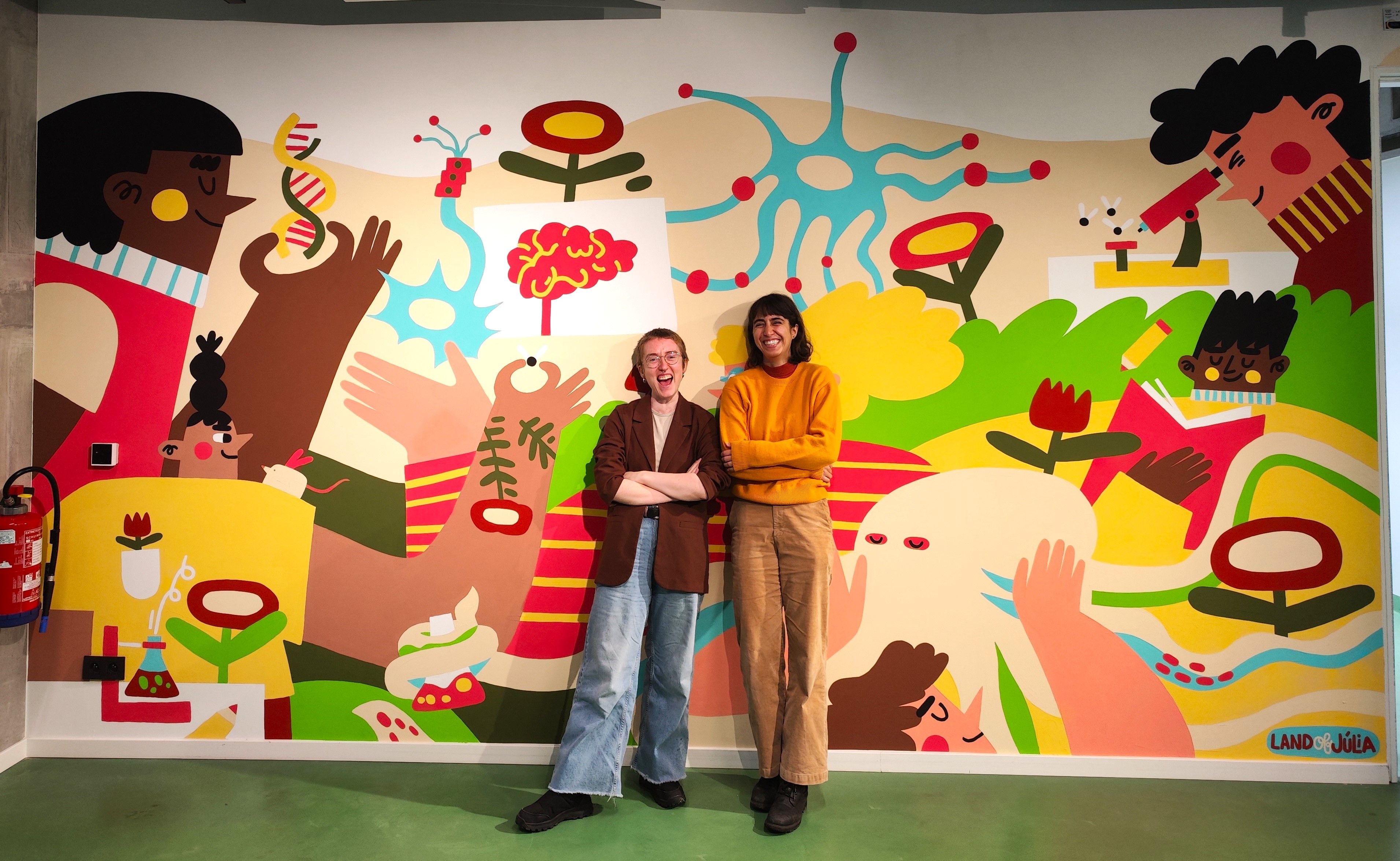At the intersection of diversity, art, and science
A conversation with science communicator Bethan Burnside and artist Júlia Mota Albuquerque
At the VIB-KU Leuven Center for Brain & Disease Research, a collaboration by the Inclusion & Diversity Committee (IDC) brought forth a week-long celebration of diversity and a beautiful mural that stands as a testament to inclusivity. We sat down with Bethan Burnside, a passionate science communicator and member of the IDC, and Júlia Mota Albuquerque, the Brazilian freelance artist behind the mural, to delve into the inspirations, challenges, and impact of their joint endeavor.
Hi Bethan, what inspired the creation of Diversity in Science Week, and what specific goals did it aim to achieve?
Bethan: This week is an initiative born from the DEI Committee and Leuven Brain Institute. The committee was established in 2018, but we wanted to gain some momentum after the pandemic by amplifying its visibility and approachability. We also wanted to celebrate the hiring of Agnes Uhereczky as the DEI officer at VIB, a valuable addition that the committee has been championing for.
What inspired your collaboration with Júlia?
Bethan: We’ve wanted to create a mural at our center for some time, and Júlia’s work at KU Leuven caught our eye. Her passion for diversity, inclusivity, and sustainability made her the perfect fit.
Júlia: I love working on murals, especially ones focused on topics I care about. When the opportunity arose, I immediately said yes!
The mural looks beautiful! What was the inspiration, Júlia?
Júlia: The inspiration came from heartfelt conversations with committee members. Each person shared their experience of being a scientist and feeling different from the stereotypical image of one. The science elements also came from our talk. I don’t really know much about what goes on in neuroscience, so I definitely needed some guidance [laughs].

How did you end up doing murals focused on diversity, inclusivity, and sustainability?
Júlia: My journey into mural art started during COVID. I returned to Brazil from the US and began painting murals as a safe outdoor activity. It was in 2020 that I moved to Europe, specifically Berlin, and started being more intentional with my art. I wanted to paint Latin women like me and include gender-ambiguous characters for broader representation. It’s been a recent focus, and I’m grateful for clients who appreciate and request this intentional diversity.
Could you elaborate on the significance of Diversity in Science Week and the mural at the center?
Bethan: The week has been a catalyst for important conversations. The mural serves as a visible trigger to continue this dialogue. It also acts as a symbolic representation of our collective commitment to diversity and inclusion.
Júlia: I hope it will contribute to creating a little space of community. Representation matters, especially in science, and the mural is a step towards addressing that gap. When people see themselves in the artwork, it becomes more than just a mural; it becomes a shared experience.
Bethan, you also gave a talk on amplifying neurodivergent voices at the LBI Neurodiversity Day. Can you tell us about some key points you discussed?
Bethan: As a neurodivergent person in science, my talk delved into the barriers faced by neurodivergent individuals in their day-to-day work. I wanted to emphasize the accommodations that we can and should be empowered to ask for. Additionally, I explored the nuanced challenge of reconciling the language used by the neurodivergent community with the more clinical language of the scientific community.
Júlia: Sounds fascinating! I would’ve loved to hear it. Research often takes time to address these issues, so it’s refreshing to have these conversations.
How do you both see diversity and inclusivity contributing to a more holistic approach in science and art?
Bethan: Diversity is not just a checkbox; it’s an advantage to science. Different brains, backgrounds, and expertise contribute to a more creative collective and scientific growth. It brings new ideas and diverse approaches to problem-solving, fostering knowledge expansion.
Júlia: When people engage in art, they are essentially telling a story. Representing stories visually through art becomes a way of informing the world about how we can build a future that accommodates everyone.
Any advice on embracing diversity in your work?
Júlia: I would say, as an artist, to immerse yourself in diverse communities. Find your place within them and see how your work can contribute positively.
Bethan: In science communication, it’s crucial to be aware of your own biases. Understand where they come from and be honest about that.
Thank you both! We hope to see many more initiatives in the future!
Watch the timelapse of the mural being created:
Want to be kept up-to-date on our biotechnological news and stories? Join our community and subscribe to our bi-monthly newsletter.
India Jane Wise
Related stories




